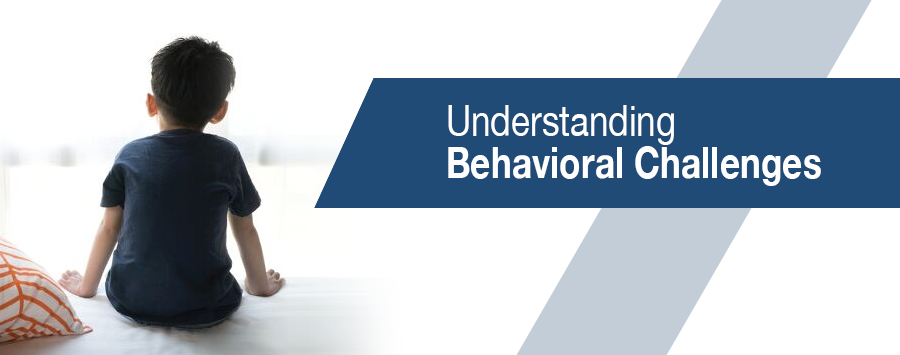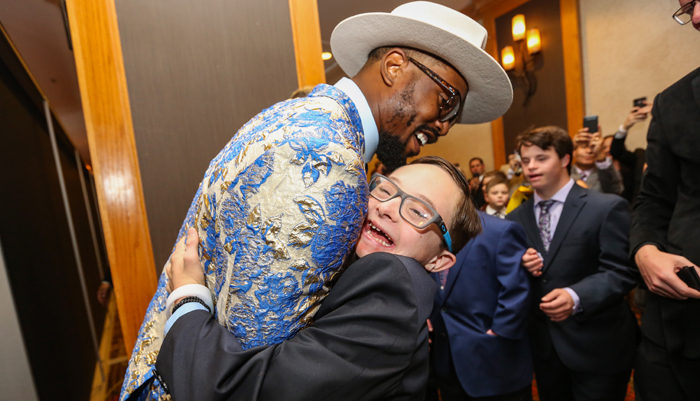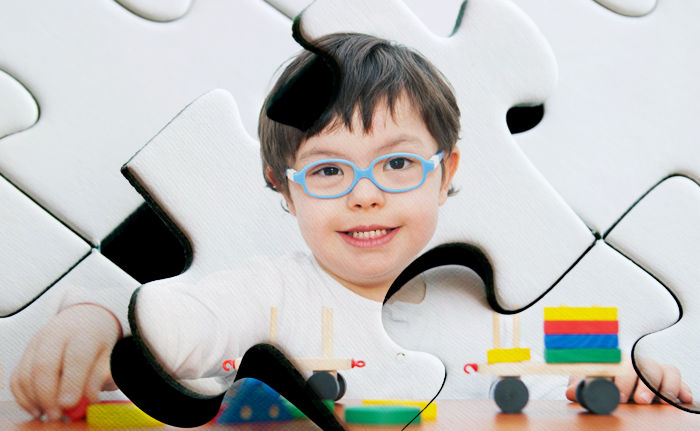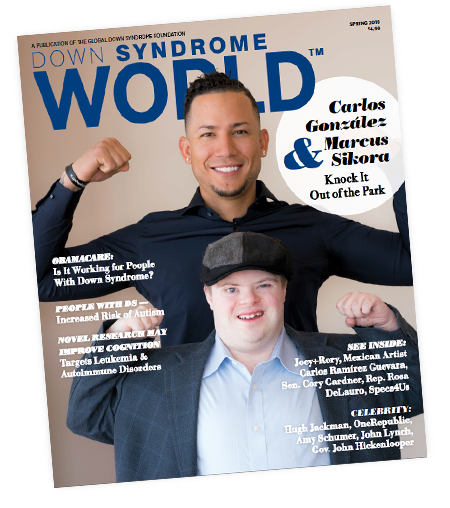Με τη μουσική ξεπέρασε τους περιορισμούς του συνδρόμου Down!
September 30th, 2019 by Global Down Syndrome Foundation
Choctaw Student With Down Syndrome Chosen For ‘Be Beautiful, Be Yourself’ Global Pageant
September 24th, 2019 by Global Down Syndrome Foundation
Kickin’ It In The Kitchen with Broncos’ Kicker Brandon McManus
September 23rd, 2019 by Global Down Syndrome Foundation
Meet DeOndra Dixon, Jamie Foxx’s Sister with down Syndrome Whom He Says Gave His Life Perspective
September 22nd, 2019 by Global Down Syndrome Foundation
Understanding Behavioral Challenges
September 19th, 2019 by Global Down Syndrome Foundation

An important study in the journal of mental health research in intellectual disabilities shows that children with Down syndrome demonstrate increased behavioral issues compared with their typical peers. Early intervention and a development strategy can help.
 This article was published in the award-winning Down Syndrome World™ magazine. Become a member to read all the articles and get future issues delivered to your door!
This article was published in the award-winning Down Syndrome World™ magazine. Become a member to read all the articles and get future issues delivered to your door! A STUDY CONDUCTED by doctors at the Anna and John J. Sie Center for Down Syndrome at Children’s Hospital Colorado, an affiliate of the Global Down S yndrome Foundation, found that 94% of children with Down syndrome experienced one or more behavioral challenges on a w eekly or even daily basis. These behaviors include wandering off, refusal to follow instructions, aggression, impulsivity, and difficulty transitioning from activity to activity. Behavioral challenges can not only impact a child’ s quality of life but also cause major str esses for parents, teachers, and other caregivers.
In the study, Lina Patel, Psy.D., and her three co-authors, Kristine Wolter-Warmerdam, Noel Leifer, and Francis Hickey, M.D., analyzed current tools for measuring behavior in children with Down syndrome to determine which methods were effective and which could be improved upon. They also surveyed parents to learn about which behaviors were the most common and if any challenges shared a common denominator. The doctors published their results in late 2018.
Children with Down syndrome have many positive behavioral traits, and typical children certainly have negative behavioral issues. However, because of lack of research, behavior issues in children with Down syndrome are less understood. Behavioral challenges can hamper a child’s ability to function independently, perform well in school or other social settings, and even handle everyday tasks, such as bathing and dressing, at home. By understanding what can trigger certain behavioral issues, parents and teachers can better develop strategies to intervene before issues progress.
COMMUNICATION TOOLS: A COMMON DENOMINATOR
A variety of factors may fuel undesirable behaviors, according to Dr. Patel, lead author and D irector of Psychology at the Sie Center.
“I feel like motivation is a key factor,” Dr. Patel says. “It doesn’t mean that children with Down syndrome are unmotivated. It might just mean they are motivated by their own interests versus the task at hand, which then may result in behavioral challenges.”
Dr. Patel and her co-authors wanted to know which behaviors parents of children with Down syndrome found most concerning. They asked parents of 274 children seen at the Sie Center from 2010 to 2015 to fill out a specially designed questionnaire. On the questionnaire, parents were asked to state the frequency with which 16 behavior challenges occurred and their level of concern about each. Parents could also name additional behavioral challenges not listed on the form. The study is one of the largest of its kind and the results were not completely anticipated.
Noncompliance, wandering, sitting down and refusing to move, and aggression were the most common difficult behaviors parents reported. The amount and frequency of challenging behaviors was much higher than previously reported in scientific literature, with nearly 100% of parents noting the existence of challenging behaviors at least weekly.
“The most striking result we found was the frequency of behavioral challenges,” Dr. Patel says. “I think we did capture a wider array of behaviors, resulting in a higher percentage of children experiencing those behaviors. The good news is that many of the behavioral challenges that we assessed can be addressed using behavioral strategies that are informed by neurodevelopment.”
Neurodevelopment is the brain’s development of neurological pathways that influence areas including memory, intellectual functioning, attention, and focus.
The researchers also wanted to determine if any of these behavioral challenges shared a common denominator. They found that the inability of a child to effectively communicate his or her wants and needs was associated with many behavioral challenges.
“Behavior is a form of communication people use when they do not have access to other methods of communication, like verbal communication,” Dr. Patel explains. “Therefore, it’s not surprising that individuals with Down syndrome would have more behavioral challenges if they do not have more functional communication strategies.”
TAKE ACTION EARLY
The longer parents allow unwanted behaviors to persist, the more ingrained these behaviors may become.
“Behavioral interventions can make a difference and really change behavior,” says Elise Sannar, M.D., Assistant Professor of Child and Adolescent Psychiatry at Children’s Hospital Colorado. “If [parents] just live with [a behavior], it’s definitely not going to get better. If kids with Down syndrome learn that if they have a tantrum or refuse to move, they’ll get what they want, that will be reinforced, and they’ll continue to engage in that behavior.”
When concerning behaviors arise, parents should notify their child’s pediatrician or primary care physician as soon as possible so medical causes can be ruled out. Many behavior issues can be triggered by medical ailments to which children with Down syndrome are more predisposed. One such medical ailment is obstructive sleep apnea, which is found in up to 70% of children with Down syndrome.
In addition, parents should pay attention to the context of behavioral challenges — when, where, and with whom they occur, and what happens before and after them, says Anna Esbensen, Ph.D., Associate Professor, Research Director at the Jane and Richard Thomas Center for Down Syndrome in the Division of Developmental and Behavioral Pediatrics at Cincinnati Children’s Hospital Medical Center.
These clues can provide important information about why behaviors occur. Parents who are concerned about a behavior that happened when they weren’t around can ask their child’s friends, teacher, or employer for information about what took place.
“Teaching the child a replacement behavior or a different way of achieving or communicating their needs are helpful ways of teaching an adaptive … method of achieving their desired function,” Dr. Esbensen explains.
She continues, “Once we understand the function of the child’s behaviors, there are evidence-based strategies that can be used to modify that behavioral challenge.”
According to Dr. Sannar, one such strategy is applied behavior analysis (ABA), which uses a variety of techniques, such as positive reinforcement, to increase helpful behaviors and decrease damaging ones. ABA can be effective in children with Down syndrome, autism, and other conditions associated with behavioral challenges.
For example, Dr. Patel says, ABA can be used to stop a child with Down syndrome from running or wandering away from caregivers, also called elopement. A behavioral analyst can collect data to better understand why the child is eloping — is he or she bored, trying to avoid a difficult task that is hard, or eager for attention? Once the analyst has an answer, he or she can create a plan to address it. For example, if the child is avoiding work that feels too hard, the analyst can slowly increase a task’s difficulty or teach the child to ask for a break.
Helping people with Down syndrome manage behaviors is important, not only for their success in school and social situations but also as they enter adulthood, says Dr. Patel.
“Many individuals with Down syndrome who have the skill to seek employment may not be able to if they have behaviors that interfere with their job,” she advises. “It may be more difficult to gain independence with things like staying home alone or even living with others if these behaviors are not addressed.”
While it is more difficult to change longingrained behaviors, therapies and strategies exist that help adults, and studies are starting to address this older population.
The researchers plan to develop a more comprehensive tool to capture the full range of behavioral health challenges that children
with Down syndrome experience. They hope such a tool would help pediatricians and other community providers determine when to refer children to a behavioral health specialist. Most importantly, by understanding and analyzing. these behaviors, they hope to empower both individuals with Down syndrome and their parents to take necessary actions to improve and maintain appropriate behaviors.
Like this article? Join Global Down Syndrome Foundation’s Membership program today to receive 4 issues of the quarterly award-winning publication, plus access to 4 seasonal educational Webinar Series, and eligibility to apply for Global’s Employment and Educational Grants.
Register today at downsyndromeworld.org!
September 2019 Newsletter
September 17th, 2019 by Global Down Syndrome Foundation
$35M in NEW NIH DS Research Funding
Courtney Gains: Advocate for Down Syndrome Awareness
September 16th, 2019 by Global Down Syndrome Foundation
An Out-Of-Sight Connection
September 12th, 2019 by Global Down Syndrome Foundation

Last year, the Global Down Syndrome Foundation’s 10th Anniversary Be Beautiful Be Yourself Fashion Show brought together two very different football fans: Denver Broncos Lineback Von Miller and one of his biggest Admirers, sports-loving 14-year-old Daniel Walshe. The two connected over their love of the game – and fashionable eyewear.
 This article was published in the award-winning Down Syndrome World™ magazine. Become a member to read all the articles and get future issues delivered to your door!
This article was published in the award-winning Down Syndrome World™ magazine. Become a member to read all the articles and get future issues delivered to your door! FOR MODELS AND ATTENDEES ALIKE, Global’s annual Be Beautiful Be Yourself Fashion Show is an unforgettable, magical experience. For Global participant Daniel Walshe, the fashion show was a chance to meet one of his longtime heroes, Super Bowl 50 MVP Von Miller. In 2011, Von was drafted by the Broncos as the No. 2 overall draft pick from Texas A&M University. Since then, the seventime Pro Bowl linebacker has posted the most sacks in the NFL. Daniel, a Broncos superfan, owns a Von Miller jersey and even rocks thick black-rimmed glasses because they look like Von’s trademark frames. Von was standing in front of the ballroom entrance when Daniel saw him, and Von greeted him with a big bear hug.
“Von was nice and friendly!” Daniel remembers..
“Both of them looked like they were having such a good time,” says Elaine Walshe, Daniel’s mom. “In fact, Daniel was so excited that a couple weeks later, he convinced us to take him to his first Broncos game to see his new friend in action.”
“I heard great things about Global’s fashion show from some of my current and former teammates that participated, like Peyton Manning and Brandon McManus,” Von says. “I went in not really knowing what to expect but wanted to go and show support for the event. I left being totally impacted by the type of community surrounding Global and the things they do. It was definitely lifechanging for me.”
TACKLING ADVERSITY & CREATING CHANGE
Being the successful athlete and force of nature on the football field that he is, it’s difficult to imagine a guy like Von Miller feeling self-conscious. But when he was a skinny, glasses-wearing fifth grader in Texas, Von didn’t feel destined for a career in professional football. In fact, at first, he had to beg his father to allow him to join a youth football team at the time because his father didn ’t believe he was ready to play. When Von finally began playing, he remembers enduring taunts from other children about his sports glasses.
“I started wearing glasses in second grade,” Von tells. “At first, I’m not going to lie, it was horrible. It wasn’t cool. When I found out I had to wear glasses, I was sad and depressed about it, but over time, I just grew into them, and they became ‘me.’ That’s how I can relate with so many kids who have glasses.”
After establishing himself as a successful professional football player in the NFL, Von was able to turn his childhood insecurities and fears into a way of inspiring children and boosting their confidence.
In 2012, he established Von’s Vision, a philanthropic organization that provides free eye exams and glasses to low-income children in the Denver area. To date, the organization has raised $5.1 million and provided over 8,500 Denver students with free eye care services. Throughout the year, Von’s Vision also funds portable optical exam centers so children in the community can get the eye exams they need.
Von was awarded the 2017 Broncos’ Community Impact Award for his charitable influence. Every spring, the team rallies in support of Von and hosts Von’s Vision Day Celebration at Broncos Stadium at Mile High. Children from identified schools and community organizations are invited to receive free eye screenings and exams. Additionally, participants are given the chance to meet Von.
“There are so many wonderful things we’ve done with the organization,” Von says proudly. “When we created Von’s Vision, I was happy to help one or two kids. To help so many kids and raise so much money for glasses is amazing. I have a wonderful team behind me that has blessed me and allowed me to impact so many lives.”
Up to 50% of people with Down syndrome will need glasses. The most common vision problems include farsightedness, nearsightedness, strabismus (crossed eyes), and astigmatism (blurred vision). Daniel started wearing glasses in kindergarten to address his farsightedness and astigmatism.
Von’s philanthropy work with eyesight and vision issues are very important and relevant to the Down syndrome community, and he understands exactly why.
“For some people with Down syndrome, it’s not that they can’t read, they just can’t see,” Von says. “They have a hard time being able to see words on a paper. That’s my life right there. I’ve always had problems with vision. I know what it feels like to have corrective vision, and I know what type of impact that can have on your life.”
Daniel is a big admirer of Von’s distinctive eyewear.
“When we went shopping for a pair of glasses a couple of years ago, Daniel was thrilled to find a pair of iconic thick black-rimmed glasses that looked like ones he’d seen on Von,” Elaine says.
Thanks to role models like Von, Daniel lets nothing stand in his way. He has faced several health problems, including chronic sinus and thyroid issues and sleep apnea, to which individuals with Down syndrome are predisposed. Daniel has benefited from medical care at the Anna and John J. Sie Center for Down Syndrome at Children’s Hospital Colorado, a Global affiliate, and knows how to have an active and healthy lifestyle. Daniel continues to pursue activities he loves, including swimming on a local rec team and playing Ultimate Frisbee and basketball on his middle-school team.
ADVOCATES FOR GLOBAL
The Walshe family became part of the Global family in 2010. Daniel met the Global staff and many new friends through medical visits and various Global events and programs.
“Global has been a tremendous support to Daniel, both socially and medically,” says Elaine. “The amount of Down syndrome resources they provide and access to specialists is incredible.”
“When we had Daniel, we were piecemealing together what medical areas were important and which doctors we should go see, just within different moms’ groups,” Elaine continues.
She adds, “Now you can go to the Sie C enter, and they will assess y our child and say, ‘Go see this specialist and that ther apist, and here’s what you need to do.’ It’s a one-stop shop, and they schedule the appointments for us. It’s been a life-changer.”
With access to great health care, Daniel has been able to participate in a variety of
Global’s Dare to Play programs, improving on his skills in soccer, football, dance, tennis, and more.
“It’s been an opportunity to meet other kids who have Down syndrome who have similar
interests,” Elaine says. “Without those programs, he probably wouldn’t have met all the wonderful friends he has.”
Daniel was also a model in Global’s 2014 Be Beautiful Be Yourself Fashion Show,
and the family continues to at tend the event every year. At the 2018 Be Beautiful Be Yourself Fashion Show, Daniel got to witness one of his heroes, Von, escort Global Ambassador DeOndra Dixon, down the runway. With encouragement from Oscar-winner Jamie Foxx, Von even put his gold suit with a blue floral pattern up for live auction. To the audience’s delight, then-Broncos quarterback Case Keenum purchased the jacket. The funds will underwrite important research and medical care for people with Down syndrome.
LOOKING FORWARD TO WHAT’S NEXT
A successful soon-to-be eighth grader who loves football stats and U.S. presidential history, Daniel is already thinking about starting high school. His parents anticipate he will go to college, enter the workforce, and enjoy an independent adult life. And Daniel has an even bigger goal — he wants to become a police officer.
“People with Down syndrome can do pretty much what they have the opportunity to do,” Elaine says.
As for Von, he is full of optimism as he prepares for his ninth NFL season
with the Broncos and a new head coach. He may be focused on the future, but he still reflects fondly on the Be Beautiful Be Yourself Fashion Show, where his life became a little richer.
“There is just so much love [from people with Down syndrome],” Von says. “I gave so many hugs that night. I walk into our facility every day with my teammates, and don’t even hug those guys, but every single person [at the fashion show] gave so much love. It was amazing.”
Like this article? Join Global Down Syndrome Foundation’s Membership program today to receive 4 issues of the quarterly award-winning publication, plus access to 4 seasonal educational Webinar Series, and eligibility to apply for Global’s Employment and Educational Grants.
Register today at downsyndromeworld.org!
Navigating a Dual Diagnosis of Down Syndrome and Autism
September 4th, 2019 by Global Down Syndrome Foundation

Finding out your child with Down syndrome has co-occurring Autism Spectrum Disorder (DS-ASD) can be daunting, but a better understanding of DS-ASD opens doors to resources and support that benefit children and families alike.
 This article was published in the award-winning Down Syndrome World™ magazine. Become a member to read all the articles and get future issues delivered to your door!
This article was published in the award-winning Down Syndrome World™ magazine. Become a member to read all the articles and get future issues delivered to your door! ACCORDING TO THE American Psychiatric Association, ASD is a complex developmental disorder that can cause problems with thinking, feeling, language, and the ability to relate to others. Symptoms occur on a spectrum ranging from mild to severe, and are characterized by challenges in social interaction, verbal and nonverbal communication, and repetitive behaviors.
Current research suggests between 8 and 18 percent of individuals with Down syndrome may also have autism. According to Sarah Hartway, R.N., M.S., President of the Board of Directors of The Down Syndrome-Autism Connection™, an additional 25 percent of people with Down syndrome may exhibit some autism symptoms but not with enough prevalence or severity to be diagnosed with DS-ASD.
“We know autism occurs more frequently in people who have other genetic or chromosomal anomalies,” Hartway said. “So it’s not surprising that people who have Down syndrome are more likely to have autism than the general population.”
SPOTTING THE SIGNS OF AUSTISM
“All children, at any given time, can exhibit behaviors that are consistent with autism, but a child with DS -ASD may engage in them more frequently or find them to be more problematic,” said Robin Zaborek, who also sits on The Down Syndrome-Autism Connection Board of Directors. “Number, frequency, and intensity of behaviors may be distinguishing factors in evaluating for DS-ASD.”
According to Zaborek, children with DS-ASD may engage in the following behaviors:
- Unusual vocalizations
- Repetitive motions, such as rocking or clapping
- Persistent, pronounced need for structure and routine
- Disinterest in playing with others
- Inappropriate laughing or crying
- Repetitive playing with an object, such as a wooden spoon
In some cases, children with DS-ASD may engage in dangerous behavior, such as running away, self-injury, or aggression. They may struggle to reach developmental milestones and have problems with eating, sleeping, and toilet training. They’re also more likely to have certain medical and behavioral conditions, including gastrointestinal issues, seizures, anxiety, and attention-deficit/hyperactivity disorder.
Fortunately, there are resources and ongoing research for people with ASD that will also benefit people with the dual diagnosis. But diagnosing DS-ASD can be a challenge. “Not all medical professionals are aware Down syndrome and autism can co-occur,”
“Not all medical professionals are aware Down syndrome and autism can co-occur,” said Margaret Froehlke, R.N., B.S.N., Secretary of the Board of Directors at The Down Syndrome-Autism Connection. “If families have a Down syndrome clinic in their community, the clinicians there would be better able to make a dual diagnosis because they have the appropriate background.”
Examples of such clinics include the Anna and John J. Sie Center for Down Syndrome at Children’s Hospital Colorado and the Thomas Center for Down Syndrome Services at the Cincinnati Children’s Hospital Medical Center.
Beyond such specialty Down syndrome clinics, Froehlke recommends parents visit a facility that belongs to the network of University Centers for Excellence in Developmental Disabilities, listed at aucd.org.
THE BENEFIT OF KNOWING
Parents of children with undiagnosed DS-ASD can feel very isolated, Froehlke said. They may look at how their child interacts with his or her peers with Down syndrome, and when their child isn’t developing in the same ways or at the same pace, they may pull away from their friends in the Down syndrome community.
“For me and many other parents, getting a dual diagnosis actually leads to relief and validation, because now you understand why your child is different,” she said. “You can begin to seek out the treatments, support, and interventions available to you.”
“There is a compassionate community of professionals and families out there who truly understand the DS-ASD journey is different,” Hartway added. “No one has to walk this path alone.”
Like this article? Join Global Down Syndrome Foundation’s Membership program today to receive 4 issues of the quarterly award-winning publication, plus access to 4 seasonal educational Webinar Series, and eligibility to apply for Global’s Employment and Educational Grants.
Register today at downsyndromeworld.org!
Friendship and Film
September 3rd, 2019 by Global Down Syndrome Foundation

 Experience our inspirational and groundbreaking videos and photos. Our children and self-advocates are beautiful AND brilliant!
Experience our inspirational and groundbreaking videos and photos. Our children and self-advocates are beautiful AND brilliant! Make sure your local Representatives are on the Congressional Down Syndrome Task Force.
Make sure your local Representatives are on the Congressional Down Syndrome Task Force.